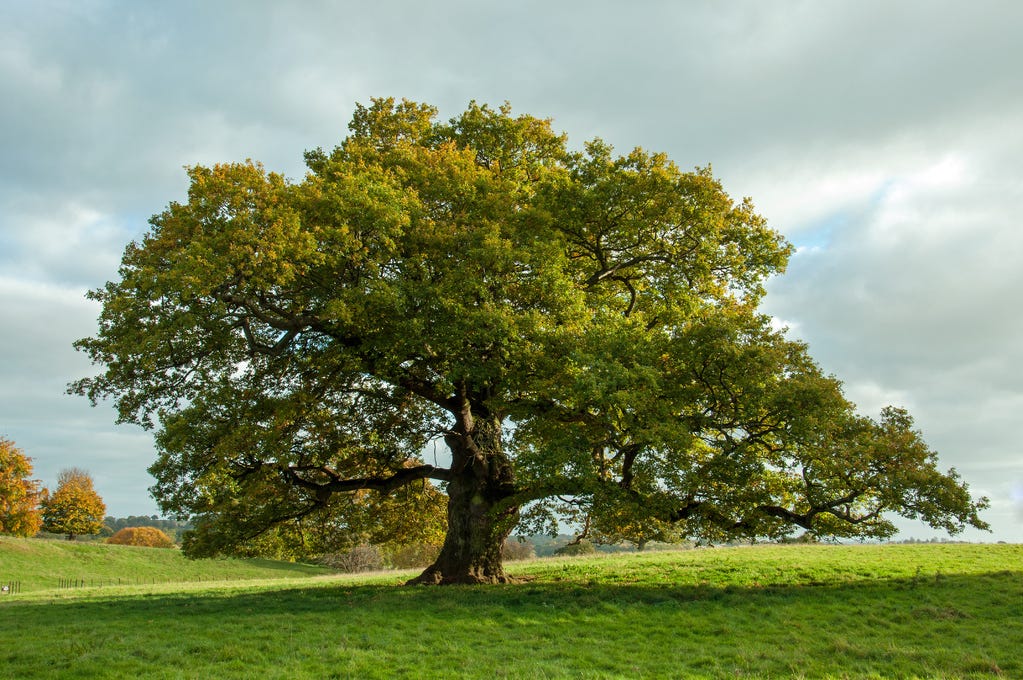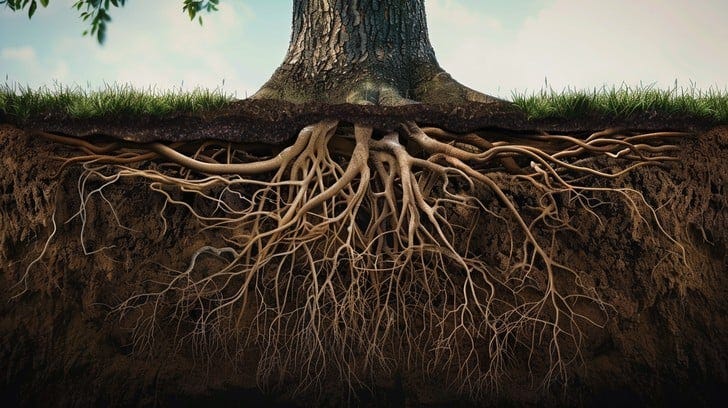Essay 2: The Roots of the Self
How to Grow Self-Security
In my essay “Foundations of Flourishing” I introduced self-security as one of the two pillars of flourishing. But what exactly is it, and how do we build it?
Self-security, which is the key to being a better, more well-rounded, more successful person, is an integrated system of beliefs, behaviors, and awareness that work together like a tree. The roots anchor you deep in the ground. The trunk provides visible strength. The branches reach toward opportunity. And the leaves react to what’s happening around you.
This essay walks through one of my frameworks for understanding and cultivating self-security, so you can build the foundation necessary for flourishing.
The Two Anchors
You need two anchors to ground your sense of self-security and give you structure. These anchors are your fundamental beliefs about your worth and capabilities.
Self-Worth: The Roots
Self-worth is believing you are inherently worthy of love and existence, independent of what you do or achieve. It’s the deepest anchor you have. You can’t function without it.
This is the hardest one to build because it often requires undoing damage from childhood: times when love felt conditional, when you learned that your value depended on being good enough, or any other harmful impressions that can be picked up, intentionally or accidentally, in your formative years.
Low self-worth usually comes from the same source: you learned that worth is something you have to earn. Through conditional love, chronic invalidation, or external validation loops where your value depends on praise, achievement, or comparison.
When self-worth is low, insecurity drives everything. You overcompensate or withdraw. You misinterpret neutral interactions as threats. You create loops that cement the belief “I am unworthy”.
Self-Esteem: The Trunk
Self-esteem is how you evaluate yourself in specific domains and situations. Can I give this presentation? Am I good at my job? It’s visible strength that varies by context1.
The problem is that people base their sense of self-esteem on external outcomes. Did my boss praise my presentation? Are my metrics higher than John’s? You feel great when you get the promotion, and terrible when John does.
External outcomes are necessary to measuring our success, and therefore necessary when it comes to developing one’s self esteem. Where people often go wrong, however, is measuring their success against other peoples’ instead of against their effort or past performance.
Low self-esteem usually stems from harsh criticism, repeated failure, constant comparison, or lack of recognition. Sometimes it comes from overpraise, which ironically creates perfectionism and terror of failure.
Self-esteem is domain-specific and task-specific. You can have high self-esteem as a parent but low about your career. You can feel confident about familiar tasks but shaky about public speaking. You can be objectively successful, attractive, accomplished and still feel fundamentally unworthy. That’s the difference between the trunk and the roots.
Self-esteem is less stable than self-worth, but more workable. You build it by doing the thing, over and over. You accumulate evidence. The data points stack up and prove that you can handle this.
The Two Regulators
There are two regulators the tree of self-security needs to stay functioning: self-respect and self-compassion. These two regulators are the equivalent of bark and sap, discipline and grace. Without balance between the two, the system collapses.
Self-Respect: The Bark
Self-respect is the integrity between what you say and what you do. It’s keeping promises to yourself. Following our tree allegory, self-respect is the bark: it’s the hard, structured exterior that protects the softness of the trunk, or self-esteem.
Every time you break a promise to yourself (hit snooze when you said you wouldn’t, skip the thing you committed to, tolerate disrespect from others), you’re sending a message to your brain: I don’t matter enough to follow through. Your brain believes it. It rewires around that belief. Over time, it becomes part of your identity and you become unreliable.
This isn’t about being harsh. It’s the opposite. It’s you saying: “I care about myself enough to do what I say I’ll do.” Self-respect is discipline.
Self-Compassion: The Sap
Sap is the lifeline of a tree. It transports vital nutrients from the roots to the leaves and back again, ensuring everything stays running smoothly. Self-compassion is the sap. It’s being kind to yourself in the face of failure without using that kindness as an excuse to keep failing.
When you mess up, self-compassion keeps it from becoming part of your identity. One broken promise doesn’t have to solidify into who you are.
Without compassion, any discipline honed from self-respect becomes punishment. And without self-respect, compassion becomes permission to abandon yourself. You need both.
Self-Awareness: The Leaves
Self-awareness is the capacity to observe yourself with honesty and clarity (your motives, biases, insecurities, and patterns) without collapsing into judgment or defensiveness.
Think of it like the leaves on a tree. Leaves flutter and move with hardly any force exerted; they’re extremely sensitive to their environment.
Self-awareness is the leaves of our security tree. Your sense of self-awareness is what helps you detect what’s actually happening versus what you think is happening; in essence, self-awareness is the hypersensitive growth tool that reacts to everything in your environment.
This is the mechanism that makes the whole tree work: without it, you can’t see where the problem actually is. Self-awareness creates the feedback loop that makes growth possible, and more importantly, it lets you see reality more objectively.
This skill is one of the most important in the 21st century. Self-awareness makes you a better, more effective person and it’s actually SO easy to cultivate. I’ll walk you through how to build this in a future essay!
How to Build It
The tree framework is diagnostic. When you feel insecure, you can ask: where in the tree is the weakness?
Damaged roots need deep work. Therapy, journaling, deliberate healing. You’re unraveling the belief that worth has to be earned. Start with noticing when you feel unworthy, and gently ask: where did I learn this? Then ask if it’s actually true.
A weak trunk needs wins. Small evidence that you can handle things. Start the project you’re avoiding. Take the class. Give the presentation badly. You don’t need to excel. You just need the data point: “I did it.”
Regulators that are out of balance need noticing. You probably lean one way: too much discipline becomes punishment, too much compassion becomes abandonment. Adjust incrementally.
Clouded awareness needs stillness. Time away from stimulation. Honest feedback from people who care. The willingness to notice without immediately fixing or defending.
Here’s the paradox: self-awareness requires baseline security to develop. If you’re drowning in shame, you can’t observe clearly. This is why healing happens in layers. A little awareness creates a little security, which allows for more awareness. It’s a spiral, not a straight line.
The Work
When you do this work, your self-security stabilizes. You stop seeking constant validation. You stop comparing obsessively. You become secure enough to be honest, to fail, to ask for help. Secure enough to serve something larger than yourself.
Because self-security is not the destination. It’s the foundation. Once you have it, you’ll notice that you stop obsessing over yourself and turn your attention outward: toward contribution, toward the transcendence that makes life feel meaningful.
Without genuine security, “purpose” becomes performance. But when you’re secure you’re free to actually care about something beyond yourself.
The tree grows slowly, but it’s vital to the earth… just like your sense of self-security is vital to you.
Thanks for reading! Shoot me a message at alex@alxmthew.com if this resonated.
Notes
[1] Unlike self-worth, self-esteem is conditional. It depends on performance, feedback, and comparison. The same applies to self-respect and self-compassion: they’re built through action and choice, not inherent. Self-worth alone is unconditional. This distinction matters because it changes how you approach building each one.








